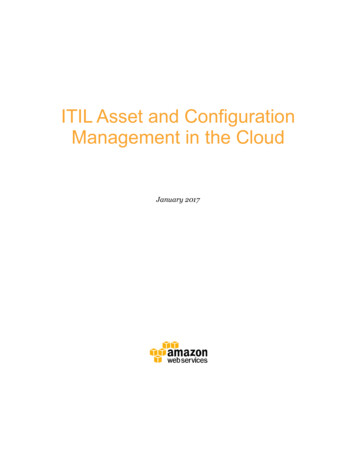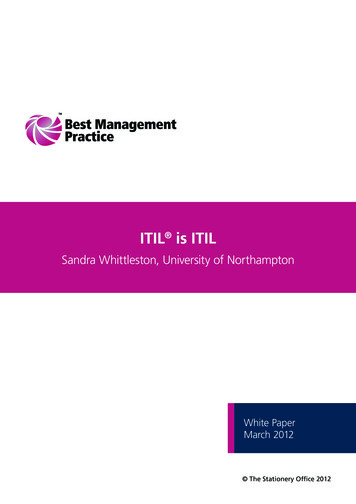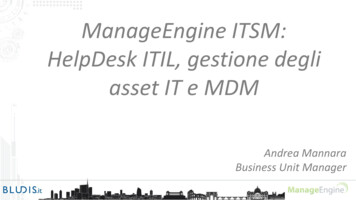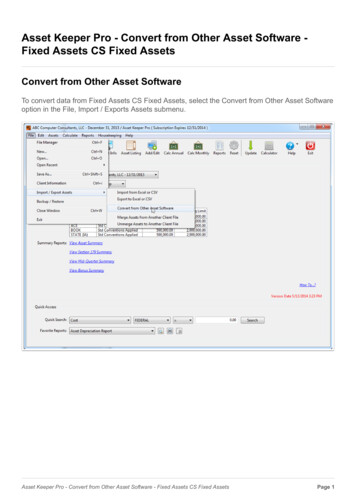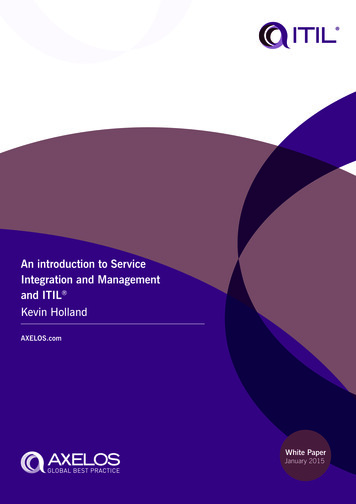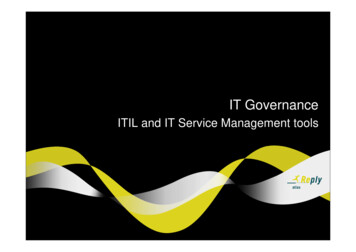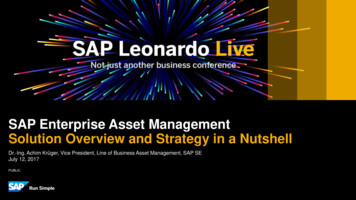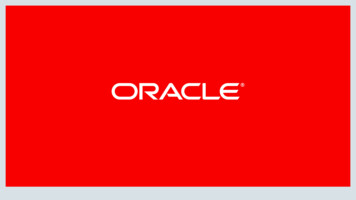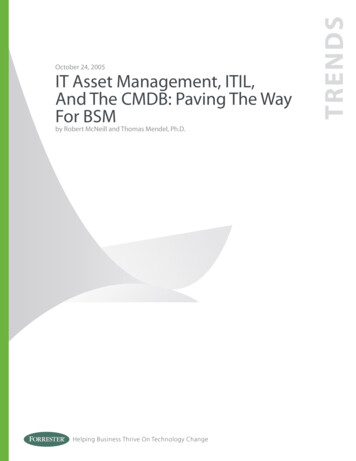
Transcription
IT Asset Management, ITIL,And The CMDB: Paving The WayFor BSMby Robert McNeill and Thomas Mendel, Ph.D.Helping Business Thrive On Technology ChangeTRENDSOctober 24, 2005
TRENDSOctober 24, 2005IT Asset Management, ITIL, And The CMDB: Paving The WayFor BSMby Robert McNeill and Thomas Mendel, Ph.D.with Jean-Pierre Garbani, Tom Pohlmann, and Kim Le QuocEXECUT I V E S U M MA RYThe journey toward running IT more like a business through business service management (BSM)requires the data feeds and processes that enable BSM — IT asset management data, ITIL processes, andapplication dependency auto-discovery technologies that populate configuration management databases.It also requires an understanding of the journey that organizations must make to improve infrastructuremanagement. BSM initiatives will fail if organizations skip investing in building blocks like thedevelopment of an accurate IT asset management system. Organizations embarking on the journey toBSM should ensure that they take manageable steps, with clear ROI targets and cyclical measurementintervals along the way.TABLE O F CO N T E N TS2 Organizations Build Value Through TheDelivery Of ServicesTake An Inventory Before Building ServicesDefine Services Where IT Asset ManagementCan Have The Greatest ImpactLink IT Asset Management To ITIL Processes ForLow-Hanging Fruit6 ITIL Starts The Journey, But BSM Must BeThe GoalThe Long And Winding Road To BSM MustInclude A Robust CMDBIt’s All About MaturityRECOMMENDATIONSN OT E S & R E S O U R C E SForrester interviewed vendor and usercompanies, including BMC Software, ComputerAssociates, Hewlett-Packard, IBM, ManagedObjects, and Peregrine.Related Research Documents“Market Update: SLM/BSM Technologies“November 9, 2004, Market Overview“Change And Configuration Management“November 8, 2004, Market Overview“Building IT Asset Management Integrity WithOutsourcers”July 12, 2004, Best Practices10 Model IT Asset Management To ServicesWHAT IT MEANS10 Align IT Asset Management With BSMStrategy 2005, Forrester Research, Inc. All rights reserved. Forrester, Forrester Oval Program, Forrester Wave, Forrester’s Ultimate Consumer Panel,WholeView 2, Technographics, TechRankings, and Total Economic Impact are trademarks of Forrester Research, Inc. All other trademarks arethe property of their respective companies. Forrester clients may make one attributed copy or slide of each figure contained herein. Additionalreproduction is strictly prohibited. For additional reproduction rights and usage information, go to www.forrester.com. Information is basedon best available resources. Opinions reflect judgment at the time and are subject to change. To purchase reprints of this document, pleaseemail resourcecenter@forrester.com.
2Trends IT Asset Management, ITIL, And The CMDB: Paving The Way For BSMORGANIZATIONS BUILD VALUE THROUGH THE DELIVERY OF SERVICESSince IT’s inception as a support function, many IT organizations have ignored the first essentialstep toward IT customer satisfaction — clearly defining what it is you are providing to end users andthe line of business. This is now starting to change:· Operational services consume the majority of the IT budget. While companies are eagerto become more responsive to business change, they continue to suffer from significantinternal resource and budget constraints. The underlying issue at stake? On average, 76% ofthe IT budget is spent on continuous IT operations and maintenance.1 IT organizations havetraditionally not focused enough on aligning operations with business services, leaving theperceived creation of value almost solely focused on application projects.· IT as a service aggregator is emerging. The growing maturity of IT organizations as serviceaggregators, essentially balancing a host of insourced and outsourced services to deliver valueto the business, is one of the key reasons why IT organizations are now building service-levelagreements (SLAs) and service catalogs. These deliverables represent the depth and breadthof the IT services offered to the lines of business, and they can be used not only to align andcommunicate the value of IT to the business but also to ensure accountability and serviceassurance.· The end-to-end service paradigm is becoming a reality. Organizing IT around servicesmeans focusing on what IT delivers, not the platforms being used. To do this, organizationsneed to understand the dependency of applications and services on the platforms in order tocontrol both service delivery cost and quality. This means moving away from a siloed view ofIT and technologies toward an end-to-end view of IT service delivery through business servicemanagement (BSM) (see Figure 1).Take An Inventory Before Building ServicesTo reach BSM, IT organizations must sort out the basics like IT asset management first. The reasonis very simple: If you don’t know what you have, you can’t build and deliver sophisticated servicelevels. IT asset management processes support the collection and provisioning of information aboutan organization’s IT portfolio. It is important because IT asset management:Is the infrastructure “glue.” Typical data includes not only the configuration and locationof an asset, but also, in some cases, the costs and service condition. IT asset management isoften thought of as the glue that bonds together all the activities that support a distributedinfrastructure.· Is still underused. CIOs need to invest in IT asset management systems to manage anincreasingly complex environment. Forrester has found that most organizations do not use ITOctober 24, 2005 2005, Forrester Research, Inc. Reproduction Prohibited
Trends IT Asset Management, ITIL, And The CMDB: Paving The Way For BSMasset management to track software assets within their organizations. This is perplexing, giventhat constantly decreasing hardware and software costs means that firms can afford more IT —which makes improving IT operational processes even more important, as both the scope andcomplexity of new digital applications increase continuously.2· Lacks a process focus. Most organizations fail at IT asset management as they underestimatethe process adherence required to get IT asset management right. IT asset management is70% process and 30% technology, but no formalized best-practice methodologies for IT assetmanagement exist. Forrester believes that industry-standard IT infrastructure library (ITIL)processes provide an opportunity to build the IT asset management data inputs and outputsrequired to enable successful IT asset management and configuration management databases(CMDBs).Figure 1 IT As The Service AggregatorBusiness usersInternal or external IT service providersService componentsEnterpriselines ofbusinessServerCustomer SLAsEnterpriselines ofbusinessHelp deskWANSupplier iselines ofbusinessEnd-to-end service deliverySupplierSLAsAppsClientsLANSource: Forrester Research, Inc. 2005, Forrester Research, Inc. Reproduction ProhibitedOctober 24, 20053
4Trends IT Asset Management, ITIL, And The CMDB: Paving The Way For BSMDefine Services Where IT Asset Management Can Have The Greatest ImpactAlthough ITIL does not specifically address IT asset management processes or frameworks, an ITasset management strategy and process is a prerequisite for a CMDB and an ITIL implementationwhose goal is to link service delivery with service support. IT asset management can have thegreatest impact on:· Software tracking. Mature asset management can: help organizations avoid unnecessary andcostly true ups with software vendors; improve an organization’s clout at the negotiating table;and fuel cost reduction efforts through reallocating used or unused software among users.Further benefits include the ability to avoid costly and potentially damaging software audits.· Lease management services. The primary benefit here is avoiding month-to-month leasepayments after the initial lease schedule has expired. By finding the asset — the principalchallenge — and then returning it in its original configuration, firms can avoid month-tomonth lease payments and possible penalties. Additionally, many leases contain “auto-renewal”clauses that renew the lease at the old terms, conditions, and prices — even though hardwareprices have continued to fall as hardware performance improves. These auto-renewal clauseswill often kick in unless firms give the leasing company written notice within the time periodspecified in the leasing contract. Auto-renewal of leases can cost an organization as muchas 40% more than is necessary, as it prevents them from negotiating better terms that takeadvantage of the price/performance curve in hardware.· Warranty tracking. The benefit here is avoiding paying twice for maintenance coverage — suchas paying for inclusion of the asset in a maintenance contract while the asset is still underwarranty. Auto-discovery tools will help companies track any enhancements or modifications todevices that may invalidate warranties — resulting in additional repair costs.· First-call resolution rates. Asset management data will reduce first-call resolution rates asagents know what assets employees have when they call the help desk. The simplest integrationbetween the help desk and the asset management system is a nightly/weekly job that updatesthe employee master in the help desk with information from the asset management system, sothat when agents check the employee’s profile, they can see what products are in place. Morecomplex integration involves the use of one of the auto-discovery tools to see dynamically whatis installed.· IMAC dispatch-to-solution rates. The number of trips that a technician has to make duringan install/move/add/change (IMAC) cycle can be significantly reduced if there is previousknowledge of the asset’s hardware and software configuration for the planned IMAC; this leadsto improved dispatch-to-solution rates for agents. Furthermore, the organization can use auditand reconciliation tools to prove that any project, such as a planned upgrade, has actually beendelivered to the end user at each stage of the project plan — with the customer able to accept orreject progress reports and invoices for both goods and services.October 24, 2005 2005, Forrester Research, Inc. Reproduction Prohibited
Trends IT Asset Management, ITIL, And The CMDB: Paving The Way For BSMLogically, a streamlined ITIL process requires IT asset management data to operate efficiently, butthe beneficiaries of an IT asset management system are often the operations of supporting processes.Availability, incident, and problem management are key areas where IT asset management can helpremediate immediate problems.Link IT Asset Management To ITIL Processes For Low-Hanging FruitMany organizations are using ITIL across the service delivery and service support process chain todefine best practices for IT service delivery processes.3 Forrester expects that implementation levelsin 1 billion-plus companies will grow from 13% today to around 40% by the end of 2006.4 This hasimportant consequences for companies. They must:· Recognize that not all ITIL processes are equal. Forrester recently interviewed 19 1billion-plus companies that have gone through a full ITIL implementation in order to betterunderstand how organizations are implementing ITIL (see Figure 2).5 We asked the firmsto rank the ITIL processes in terms of perceived importance and value for their overall ITservice delivery process. Incident management, which deals with solving immediate issues thataffect the overall health of the services, came out as the clear winner. This is hardly surprising,considering that setting up a structured process for reacting to a crisis makes good sense as astarting point.Figure 2 The ITIL Processes“Please rank the importance of the ITIL processes for your overall IT service delivery process.”(1 [least important] to 10 [most important])Average scoreIncident management8.74Service-level management7.74Configuration management7.16Availability management7.00Change management6.79Continuity management6.05Release management4.00Problem management3.00Financial management2.53Capacity management2.00012345678910Base: 19 IT managers at 1 billion-plus companiesSource: Forrester Research, Inc. 2005, Forrester Research, Inc. Reproduction ProhibitedOctober 24, 20055
6Trends IT Asset Management, ITIL, And The CMDB: Paving The Way For BSM· Map the ROI between ITIL and IT asset management integration. Organizations shouldidentify the ITIL services where IT asset management can have the greatest return oninvestment (ROI) — organizations should not implement a complete life-cycle approach to ITasset management in one go. Integrate IT asset management with processes that mirrorinvestments in an ITIL implementation. As organizations phase their investment in ITIL, theyshould map the IT asset management requirements of the ITIL processes to build a businesscase for improved integration. Firms have achieved positive ROIs from integrating IT assetmanagement processes with a wide range of ITIL processes, including incident management,configuration management, change management, release management, and problemmanagement.6· Treat ITIL as a means, not an end. While ITIL best practices are certainly the foundationfor a better control of how IT delivers services, they are not a foundation for business processmanagement or managing IT from a business process perspective. Organizations shouldn’tview ITIL as the end point for IT service optimization; the framework lacks actionablerecommendations, making it an excellent guide or checklist but not a series of implementationblueprints. Further, ITIL is rather hermetic in terms of scope beyond IT services, as it does notprescribe how IT relates to the changing needs of the business or the extended enterprise, suchas partners. The No. 1 issue we still hear from IT executives is the challenge of re-architectingIT services to business demands. We believe that BSM will increasingly become the end goalfor organizations, and IT asset management strategies will increasingly be designed around thegrowing demands of a BSM strategy.ITIL STARTS THE JOURNEY, BUT BUSINESS SERVICE MANAGEMENT MUST BE THE GOALAligning IT asset management to ITIL is a solid way of optimizing IT service processes, but it doesnot help much in terms of true IT business alignment. To achieve this, IT organizations should keepin mind that:· BSM requires a top-down, not bottom-up, approach to IT services delivery. IT organizationsshould concern themselves with designing the right processes and services with the businessand then work out what data the teams require to perform these services. True businessalignment has to be implemented in a top-down manner, not from the bottom up, where theITIL frame of reference originates. If an organization is to align IT with the business, it has tocarefully model the dependencies of the applications and infrastructure to the business process.· Service-level management is only the first step, yet again. It is important to distinguishbetween the two different facets of service management: service-level management (SLM)and BSM. A service is defined as a discrete offering from an IT department or external serviceprovider. An SLA is a contract between a business and an IT service provider, internal orexternal — and the process of measuring service quality, reporting results, and taking action toOctober 24, 2005 2005, Forrester Research, Inc. Reproduction Prohibited
Trends IT Asset Management, ITIL, And The CMDB: Paving The Way For BSMensure the quality stays within agreed parameters. The key difference between SLM and BSMis that BSM takes a more business-focused view of the definition of a service, such as time tocash, as opposed to an IT-centric view, such as the availability of an ERP system. Gaining agood understanding of how to describe a business process is therefore a key capability for BSMproducts.7 That’s why vendors like IDS Scheer invest a lot of time and effort in making it easy forclients to first describe their business processes and then ultimately automate the mapping ofthose to the infrastructure components. For IT departments, this unfortunately means that theyhave to learn how to walk (SLM) before they can start to run (BSM).The Long And Winding Road To BSM Must Include A Robust CMDBA CMDB stores a multitude of configuration items (CIs), ranging from assets like servers and PCs,to financials like contacts and purchase information, to infrastructure component information. Italso stores the relationships between these CIs and higher-level entities like applications, services,and, in the most advanced implementations, even business processes. Why is this important?· Discovery and mapping innovations enable BSM. The addition of features around applicationto-infrastructure component mapping has changed the face of the CMDB and has finallyenabled BSM. Application mapping is at the heart of BSM because it enables management ofservices, not components; this has taken system management to the next level of intelligence.A true CMDB is created by using two key types of input — IT asset management data andapplication mapping auto-discovery data (see Figure 3).Figure 3 The CMDB Input And OutputConfigurationmanagementAsset ymanagementSource: Forrester Research, Inc. 2005, Forrester Research, Inc. Reproduction ProhibitedOctober 24, 20057
8Trends IT Asset Management, ITIL, And The CMDB: Paving The Way For BSM· Vendors are actively promoting CMDBs. As IT asset management tools feed the CMDB, theleading IT asset management vendors like BMC, CA, IBM Tivoli, and Peregrine have embracedITIL and the CMDB as a central component of their offerings. Most of the current innovationaround the CMDB isn’t coming from the IT asset management market but from applicationdependency mapping technology vendors like BMC, CA, Cendura, Collation, nLayers, Relicore,Mercury, and Tideway Systems. Leading IT asset management and systems managementproviders, are making increasing efforts to integrate asset portfolio management repositoriesand the CMDB. CMDBs built on mature IT asset management tools form the foundation foreffective change, configuration, incident, problem, and release management.BSM is becoming ever more sophisticated. Cutting-edge companies like Fidelity Investments,T-Mobile, HSBC, and ING continue to deploy ever more sophisticated BSM tools; the ultimategoal is to automate the delivery of complete business processes, even across the extendedenterprise, which includes business partners and outsourcers of various service components.This is far more complicated than implementing basic end-to-end management for standardIT services. The gap in implemented functionalities between mainstream SLM technologies,as described in the ITIL books, and cutting-edge BSM technologies is therefore wideningcontinuously. As a result, traditional infrastructure management tool vendors will increasinglydominate the SLM market; the BSM side of the market will continue to be a dynamic area ofhigh innovation, particularly around better defining business processes, dynamically mappingbusiness needs to IT services, and enabling true end-to-end service delivery chains for theextended enterprise. This, finally, is where the CMDB brings together ITIL and IT assetmanagement to enable BSM.It’s All About MaturityThis is what the journey toward BSM will look like (see Figure 4):8· Stage one: chaotic. Forrester estimates that 35% of global 1 billion-plus companies are heretoday. Characteristics include limited formal processes for managing IT. In a recent survey, wefound that 35% of organizations do not have a process methodology for managing IT.9· Stage two: reactive. Forrester estimates that 44% of global 1 billion-plus companies are heretoday. Characterist
Include A Robust CMDB It’s All About Maturity RECOMMENDATIONS Model IT Asset Management To Services WHAT IT MEANS Align IT Asset Management With BSM Strategy NOTES & RESOURCES Forrester interviewed vendor and user companies, including BMC Software, Computer Associates, Hewlett-Packard,
